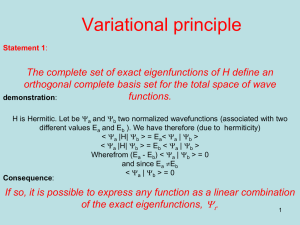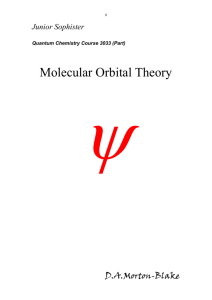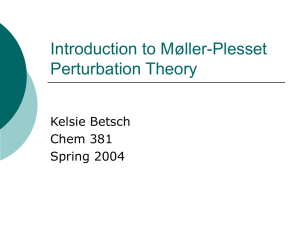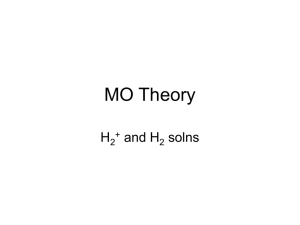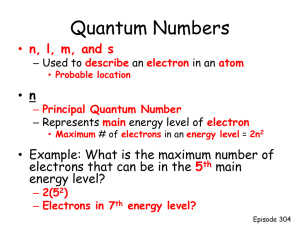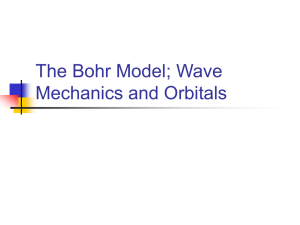Molecular Perturbations
advertisement
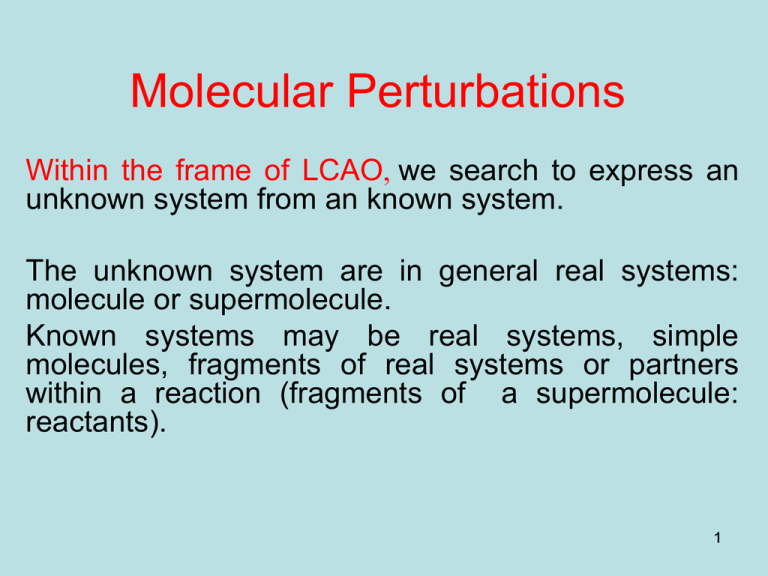
Molecular Perturbations Within the frame of LCAO, we search to express an unknown system from an known system. The unknown system are in general real systems: molecule or supermolecule. Known systems may be real systems, simple molecules, fragments of real systems or partners within a reaction (fragments of a supermolecule: reactants). 1 Molecular Perturbations i= Sr crfr and Ei are solutions for a known system. We like to find solutions 'i= Sr c'rfr and E'i for an unknown system that is resembling (whose Hamiltonian, H', does not differ by much from H). If so, solutions (E'i,y'i) are close to (Ei,yi) and P=H’-H is an operator whose terms Pij=[<yi|P|yj>]* are weak. P is the operator defining the perturbation. *data usually characterize atoms pij=<fi|P|fj> which are few terms but no so small (a bond formation between fi and fj). Pij=<yi|P|yj> are derived from the pij. Pij are significantly weaker than pij due to delocalization of AOs within MO expressions. In general, results remain significant even though some pij are important. 2 Molecular Perturbations 'I = S ai I = Sr crfr unknown MOs, 'i, are linear combinations of known MOs, i, that are linear combinations of AOs, fi; they are hence linear combinations of AOs, i. If we were to find exact solutions 'i= Sr c'rfr it we be easier to solve the secular determinant directly. The advantage of using perturbations is to make it within approximations but simply. 3 Molecular Perturbations “Simply” means not rigorously that is somehow negative. However ° understanding (as opposed to modeling) is always a work of simplification. ° perturbation is a direct comparison. We search for the difference between 2 large numbers (total energies) with a large error bar each. The difference calculating them independently and making the difference may be large. A direct estimation of the difference even using simple theory may be more precise. 4 Molecular Perturbations Secular determinant without perturbation: If known, the secular equation is solved (diagonal)! E1-E 0 0 0 E2-E 0 =0 0 0 Ej-E 5 Molecular Perturbations Secular determinant with perturbation: E1+P11-E P12 P1j P21 E2+P22-E P2j =0 Pj1 Pj2 Ej+Pjj-E We search to develop the determinant, retaining only the largest terms. One term is larger than any other: the diagonal. 6 First order Energy solution Since perturbations are small, all the Pij are small and the largest terms are those from the diagonal: Searching for E’j close to Ej, every term of the diagonal is large except one: E’i - Ej= Ei - Ej which is not small (assuming no degeneracy). Only one term is small; that for j: E’i - Ej= Pjj is a “first order” small term. Expressing the determinant, the product of the terms of the diagonal is contains the smallest number of small terms and is the greatest. The secular determinant is P (E’i+Pii-E) = 0 → E’j = Ej+ Pjj 7 Orbital associated with the First order Energy solution (Zero order) Searching for y’ close to y j j Secular equation: Pj1 a1 + Pj2 a1 + …+ (Ej+Pjj-E) aj + …+ Pjn an = 0 All the terms are small except one. All the ai are zero except aj. aj=1 The orbital is unperturbed to this order y’ =y j j 8 Second order Energy solution Developing the determinant is: the diagonal - all the terms obtained by a single permutation of two terms in the diagonal + negligible terms. Searching for E’j close to Ej, The secular determinant is P(E’i+Pii-E) - S[(E’ +P -E) (E’ +P -E)] i (P (E’i+Pii-E)P*ijPji i ii j +e=0 jj Secular determinant without perturbation: E1+P11-E P12 P1j P21 E2+P22-E P2j =0 Pj1 Pj2 Ej+Pjj-E 9 Second order Energy solution P(E’i+Pii-E) - S [(E’ +P -E) (E’ +P -E)] i (P (E’i+Pii-E)P*ijPji i P(E’i+Pii-E) [1 S – i ii j S E – Ej – Pjj = - i S ] [(E’ +P -E) (E’ +P -E)] ii P*ijPji (E’i+Pii-E) i jj P*ijPji i -(E’j+Pjj-E)= - +e=0 j =0 jj ] P*ijPji (Ei-Ej) 10 Second order Energy solution E = Ej + Pjj + S E’j = Ej + Pjj + For real terms P*ijPji i S (Ej-Ei) i P*ijPji (Ej-Ei) Dimension of an energy: Square of an energy over an energy E’j = Ej + Pjj +Si Pij2/ DE Second order term (2 orbital mixing) If Ej< Ei stabilization of the orbital of lower energy If Ej>Ei destabilization of the orbital of higher energy 11 Increases the energy gap Orbital associated with the second order Energy solution (first order) Secular equation: Pi1 a1 + Pi2 a2 + …+ (Ei+Pii-E) ai+ Pij aj + …+ Pjn an = 0 Product of 2 small terms not small terms if ij not small terms if ij Second order First order First order no dimension Searching a solution close to j, the ith line has small terms of the first order. ai = Pij/DE aj The orbital is y’ = y S j j + ij Pij/(Ei-Ej) y i Such expression is not orbital is not normalized and has to be multiplied by 1/√N In phase for the lowest combination 12 Combination of 2 AOs of same symmetry Ei’-Ei = Pij2/ DE y’ = y S j j + ij Pij/DE y i Two orbital mixing: a bonding combination and an antibonding one. The bonding orbital is the in-phase combination Antibonding Niveau Antiliant is issued from the orbital of lowest energy A (larger coefficient of mixing) B A The antibonding orbital is issued from to the orbital of highest energy The interaction widens the gap; It is more important when S is large and DE small • 10 eV rule • Frontier orbitals B A B Niveau liant Bonding 13 2 OA interaction degenerate or close in energy -D/2 D/2 b f1 f2 f1 D/2 -E b f2 b -D/2 -E =0 (D/2 -E) (-D/2 -E) = b2 E2 - (D2 /4) = b2 E2 = b2 + (D2 /4) E = ±√[b2 + (D2 /4)] general • If D = 0, E+ - E = b √ (b2+D2/4) The geometric mean of b and D/2 • If b <<D, E+ = (D/2) (1 + 4 b2/ D2) 0.5 E+ = (D/2) (1 + 2 b2/ D2) = D/2 (1 + 2 b2/ D) E+ - E = b2/ D 2nd order Perturbation term 14 Frontier Orbitals • due to perturbation formula: Ei’-Ei = Pij2/ DE • SOMO, HOMO and LUMO • The least stable but the most mobile electrons • The largest amplitude on the weakly bound atoms that are reactive sites. Kenichi Fukui Japan Nobel 1981 15 3rd order perturbation Case of two fragments interacting. The perturbation is the interaction between fragments (without perturbation within each fragment) Permutation between 3 lines of the determinant: ’1 = ’1 + P1b E1-Eb b + P1b Pb2 (E1-Eb) (E1-E2) 2 2 1 A Fragment : The orbital 1 and 2 belong to the same fragment and are orthogonal inside A b B Fragment : A single orbital 1 and 2 both interact with b; they mix, the phase relation being imposed by their relation with B. This causes polarization 16 S. Imagaki, H. Fujimoto K. Fukui J. Amer. Chem. Soc 98 (1976) 4054 L. Libit R. Hoffmann J. Amer. Chem. Soc 96 (1974) 1370 rd 3 order perturbation another view point:excitation ’1 = ’1 + P1b E1-Eb b + P1b Pb2 (E1-Eb) (E1-E2) 2 2 1 A Fragment : The orbital 1 and 2 belong to the same fragment and are orthogonal inside A b B Fragment : A single orbital 1 and 2 mix. 1 is partially depopulated and 2 becomes partially populated. This corresponds to mix with an excited state: IC 17 S. Imagaki, H. Fujimoto K. Fukui J. Amer. Chem. Soc 98 (1976) 4054 L. Libit R. Hoffmann J. Amer. Chem. Soc 96 (1974) 1370 3rd order perturbation ’1 = 1 + P1b/(E1-Eb) b At variance with 1, ’1 is not orthogonal to 2 ’’1 = ’1 + P1’2/(E1-E2) 2 Let express P1’2 by developing ’1 P1’2 = < ’1 IPI 2 > = < 1 IPI 2 > + P1b/(E1-Eb) < b IPI 2 > P1’2 = 0 + P1b Pb2/(E1-Eb) ’’1 = ’1 + P1b Pb2/ [(E1-Eb)(E1-E2)] 2 ’’1 = 1 + P1b/(E1-Eb) b + P1b Pb2/ [(E1-Eb)(E1-E2)] 2 2 1 b B Fragment : A Fragment : The third order terms account for the polarization of the fragment 18 Eb below E1 y2 - + y1 - 1 + 1 2 b y' 1 b y' 2 Increases decreases ’1 = ’1 2 - b + 2 Decreases increases ’2 = ’1 - b + 2 19 Eb intermediate between E1 and E2 y2 + y1 - + + 1 + 1 2 y' 1 b y' 2 Decreases increases ’1 = ’1 2 b + b + Decreases increases 2 ’2 = ’1 - b+2 20 Eb above E1 + + y2 - + y1 - + 1 2 1 b y' 1 b y' 2 Decreases increases ’1 = ’1 2 + b + Increases decreases 2 ’2 = ’1 - b-2 21 Examples To judge the method, we will search for known systems (easily calculated without perturbation) • Cyclobutadiene from butadiene 22 Cyclobutadiene from Butadiene -.3717 -.6015 -1.618 0.3717 0.6015 0.6015 C2 C4 C1 C2 C1 C3 -.3717 0.6015 C4 -.3717 -.618 C2 -.6015 0.3717 0.618 -.3717 0.6015 0.3717 0.6015 1.618 0.6015 0.3717 23 MO Energies from perturbation What we know is <f1IPIf4> = 1: there is a bond between atoms 1 and 4 that did not exist for butadiene A Mirror symmetry is preserved S S A A Only orbitals of the same symmetry mix together 24 Conservation of Orbital Symmetry H C Longuet-Higgins E W Abrahamson The Molecular orbitals are solution of the symmetry operators of the molecule. MOs from different symmetry groups do not mix. Hugh Christopher Longuet-Higgins 1923-2004 25 Orbitals ’1 from perturbation 26 New lowest orbital ’1= (fA + fB+ fC+ fD ) + < 1 IPI 3>/(E1-E3) (fA -fB-fC+ fD ) + 0.2 The + sign means in phase between 1 and 4 The new orbital looks like 1 but with modulation of amplitude indicated by red arrows 27 Exact solutions First set 1/2 -2 b 1/2 1/2 0 1/2 2b 28 Exact solutions Second set 1/2 -2b 1/√2 1/√2 0 1/2 2b 29 Solutions are very accurate even though <fiIPIfj> is large (introducing a bond as strong as others). < iIPIj> MOs are less large due to delocalization of AOs with MOs. 30 Butadiene from 2 ethylenes 1/√2 (fA - fB) 1/√2 (fA +fB) 1/√2 (fC - fD) 1/√2 (fC +fD) 31 Butadiene from 2 ethylenes first order terms -1.5 b 1/√2 (fA - fB) 1/√2 (fC - fD) -0.5 b 0.5 b 1/√2 (fA +fB) 1.5 b 1/√2 (fC +fD) < 1/√2 (fA +fB)IPI1/√2 (fc +fD)> = 0.5 b 32 Butadiene from 2 ethylenes second order terms -1.5 b - 0.125 b = -1.625 b 1/√2 (fA - fB) 1/√2 (fC - fD) -0.5 b- 0.125 b = -0.625 b 0.5 b+ 0.125 b= 0.625 b 1/√2 (fA +fB) 1.5 b + 0.125 b = 1.625 b 1/√2 (fC +fD) [< 1/√2 (fA +fB)IPI1/√2 (fc +fD) >]2 / (b-(-b))= 0.125 b 33 P has to be calculated on the unperturbed MO expressions (before taking into account 1st order perturbation) New lowest orbital ’1= (fA + fB+ fC+ fD ) + < 1 IPI 3>/(E1-E3) (fA -fB-fC+ fD ) + 0.5/2.0 The + sign means in phase between 2 and 3 1.25 0.75 0.75 1.25 without normalization 0.606 0.364 0364 0.606 normalized 34 The total energy stabilization comes only from second order terms (interaction between occupied and vacant orbitals) E = 4 * 0.125 = 0.5 b This is the energy due to the delocalization. 35 Butadiene from 2 ethylenes minimizing the repulsion 0.5 b 1/√2 (fA +fB) 1/√2 (fC +fD) 1.5 b It is better to reduce the overlap: not making bond between atoms 1 and 4 ! Making trans rather than cis butadiene Avoiding closing ring to cyclobutadiene 2 1 3 4 1 2 3 4 36 Cyclobutadiene from 2 ethylenes Only one mirror symmetry is preserved by perturbation 37 cyclobutadiene from 2 ethylenes first order terms -2 b 1/√2 (fA - fB) 1/√2 (fC - fD) -0.0 b 0.0 b 1/√2 (fA +fB) 1/√2 (fC +fD) 2b <1/√2 (fA +fB)IPI1/√2 (fc +fD)> = b No terms from second order 38 Conservation of Orbital Symmetry H C Longuet-Higgins E W Abrahamson The Molecular orbitals are solution of the symmetry operators of the molecule. MOs from different symmetry groups do not mix. Hugh Christopher Longuet-Higgins 1923-2004 39 Non-crossing rule Energy The potential energy curves of two MOs do not cross unless they have different symmetry. If the MOs are of the same symmetry, they interact. The interaction increases when the energy levels are close. This opens a gap and prevents crossing. Reaction coordinate or any transformation 40 Non-crossing rule The potential energy curves of two electronic states of a diatomic molecule do not cross unless the states have different symmetry. Energy of states If 2 states are of the same symmetry, they interact. The interaction increases when the energy levels are close. This opens a gap and prevents crossing. distance 41 Non-crossing rule ionic Atomic or covalent ionic atomic Mixed ionic and covalent 42 Benzene from pentadienyl + C radicals pentadienyl radical without calculations 1. What are the coefficients of the SOMO? 2. What are the coefficients of the bonding MO antisymmetric relative to the mirror? 3. What is the corresponding Energy level? 4. What are the coefficients of the bonding MO symmetric relative to the mirror? 5. Deduce from them the MO Energy level? 43 pentadienyl radical using only symmetry and Normalization. E = -√3 b What are the coefficients of the SOMO? What are the coefficients of the bonding MO antisymmetric relative to the mirror? What is the corresponding Energy level? What are the coefficients of the bonding MO symmetric relative to the mirror? E = -b E=0 Deduce from them the MO Energy level? E=b E = √3 b 44 pentadienyl radical using only symmetry and Normalization. E = -√3 b What are the coefficients of the SOMO? 1/√12 Use alternant property -1/2 What are the coefficients of the bonding MO -1/2 antisymmetric relative to the mirror? 1/2 1/√3 a double bond, symmetrized What is the corresponding Energy level? What are the coefficients of the bonding MO symmetric relative to the mirror? 1/√12: 1/3 +2 (1/2)2 + 2 c2 =1 1/2: 2 (1/2)2 + 2 c2 + 0 =1 1/√3: 1/3 +2 c2 + 0 =1 Deduce from them the MO Energy level? Develop <IHI> 4 [(1/√12)(1/2)+(1/2)(1/√3)]= √3 E = -b 1/√3 E=0 1/2 -1/√3 1/2 1/√12 1/2 E=b E = √3 b 1/√3 45 Benzene from pentadienyl + C radicals First order term. E = -√3 b -1.155 b 1/√12 -1/2 -1/2 1/2 1/√3 E = -b E=0 1/√3 2/√3 = 1.155 b E=0 1/2 -1/√3 1/2 1.155 b 1/√12 1/2 E=b E = √3 b 1/√3 46 Radical chain + C radical atom comparing the chain with the ring: Aromaticity First order term. S E=0 E=0 4/√(N-1) for the ring 2/√(N-1) for the chain A E=0 E=0 0 for the ring 2/√(N-1) for the chain 47 Radical chain + C radical atom comparing the chain with the ring: Aromaticity Aromaticity according to Dewar S A When the SOMO is symmetric The ring is more stable than the chain The polyene is AROMATIC N-1 is even N = 4n +2 When the SOMO is antisymmetric The ring is less stable than the chain The polyene is ANTIAROMATIC N-1 is odd N = 4n 48 Benzene from pentadienyl + C radicals Second order terms. (2/√12)2/√3=0.1924 -1.925 b E = -√3 b 1/√12 -1/2 -.962 b 1/√3 E=0 0.962 b 1/√12 1/2 1.925 b E = √3 b 1/√3 49 Benzene from pentadienyl + C radicals (2/√12)2/√3=0.1924 Second order terms. -1.925 b 0.1924 -1.155 b 0.1924 E = -√3 b E = -√3 b 1/√12 -1/2 -1/2 -b 1/2 -0.962 b 1/√3 E = -b E=0 0.962 b 1/2 b 0.1924 1.155 b -1/√3 1/2 E = √3 b 0.1924 1.925 b 1/√3 1/√12 1/2 E=b E = √3 b 1/√3 50 Benzene from butadiene+ethylene -.3717 -.6015 -1.618 0.3717 0.6015 0.6015 C3 + -.3717 -.618 0.6015 -.3717 C4 C4 C2 C1 C5 C6 C3 C5 C2 C6 C1 -.6015 0.3717 0.618 -.3717 0.6015 0.3717 0.6015 1.618 0.6015 0.3717 51 Benzene from butadiene+ethylene Whire arrow: [2(1/2)0.6015)2/1.618 = 0.447 b Black arrow: [2(1/2)0.3717)2/0.618 = 0.447 b -2.065 b A -1.618 b -0.447 b -1.065 b S -0.618 b A 0.618 b S -0.447 b 0.447 b 1.618 b -0.447 b A -1.0 b S 1.0 b 0.447 b -0.447 b 1.065 b 0.447 b 0.447 b 2.065 b 52 Fulvene 0 . 75 -0 . 36 -0 . 19 0 . 66 -0 . 44 -0 . 44 0.15 Here are 4 MOs Find the missing ones (coefficients and Energy) -0 . 35 -0 . 35 0.28 0.15 E = -0.25 b E = -1.86 b 0 . 25 -0 . 5 Justify the energy 1b for the orbital at the bottom left 0.52 -0 . 5 Is fulvene more likely a donor 0.0 or an acceptor? 0.0 0.5 0.5 E = 1. b 0.28 0.43 0.43 0.39 0.39 E = 2.12 b 53 The two antisymmetric orbitals are from a butadiene (no contribution on the C that belong to the mirror plane) 0.618 b -1.618 b 54 A non bonding orbital made of two pCC Is fulvene more likely a donor or an acceptor? The LUMO level -0.25 b is low in energy Fulvene is an acceptor (interacting with an electron rich dienophile such as : CH2=C(OMe)2 E= b LUMO: E=-0.25 b 55 Hexatriene Let call 1= af1 + bf2 + cf3 + c4f4 + c5f5 + c6f6 the lowest orbital 1. Identify a, b and c to the numbers 0.232, 0.418 and 0.521. 2. Express c4, c5 and c6 in terms of a, b and c 3. What relationship connects a, b and c? 4. Give energy E1 of 1 as a function of a, b and c. Calculate E1. 5. The coefficients of the other orbitals are obtained by the following permutations: c1 c2 c3 3 c a b 2 b c a 1 a b c Give c2 et c3 the sign of the coefficients (c1 will be conventionally chosen as positive). We give E2=1.247 b et E3=0.445 b. 56 Hexatriene Let call 1= af1 + bf2 + cf3 + c4f4 + c5f5 + c6f6 the lowest orbital 1. a=0.232 b=0.418 c=0.521 2. Express c4, c5 and c6 in terms of a, b and c: c6=c1 c5=c2 and c4=c3 3. What relation link a, b and c? a2+b2+c2 = 0.5 4. Give the energy E1 of 1 as a function of a, b and c. Calculate E1. 4ab+4bc+2c2 = E1 = 1.802 b. 5. The coefficients of the other orbitals are obtained by the following permutations: 3 2 1 c1 c2 c3 c a b b c a a b c 2 c2 and c3 are positive 3 c2 is positive an c3 is negative. E2=1.247 b and E3=0.445 b. 57 Ring C14 and pyrene by perturbation from hexadienes y A 1' 1 2' 2 3' 3 4' 4 5' x 5 6' 6 B pyrène 2 hexatrienes + atoms A and B 58 The antisymmetric combinations remain unperturbed -2. - 1.802 A S - 1.247 A - 0.445 S A y A 1' A+S 1 2' 2 3' 3 4' 0.445 A 4 5' 6' S 1.247 x 5 6 B A 1.802 S 2 HEXATRIENES Hexatriene A,B EN C14 CANNULENE A,B 14 ring en pointillé les correspondances entre orbitales antisymétriq ues par rapport au plan contenant A et B 59 The Symmetric combinations interact y -2. - 1.802 - 1.247 A S 1 2' 2 3' A 3 4' 5 6' S x 4 5' - 0.445 S A 1' 6 B A+S 0.445 1.247 1.802 y A 1' 1 2' A 2 3' S 2 3 4' 4 5' HEXATRIENES ANNULENE EN C14 A A S A,B x 5 6' 6 B en pointillé les correspondances entre orbitales antisymétriq ues par rapport au the plan contenant degenerate (except lowestA et B Orbitals are and highest levels); correlation jumps from one energy level to the next. 60 Interaction with C=C 2 stabilizing interactions between Frontier Orbitals HOMO S y LUMO S y pyrène A 1' 1 2' A 2 3' 3 4' 4 5' A x 5 6' 1' 1 2' 2 3' 3 4' 4 5' 6 B S x 5 6' 6 B LUMO HOMO 61 CH2 H2C C Trimethylenemethane CH2 √(2/3) 1/√3 -1/√6 From symmetry, 4 degenerate orbitals; 2 of them remain non bonding, The two other mix (3(1/√3)b). This is a diradical 1/√6 -1/√2 -√3 b 1/√3 1/√6 1/√2 √3 b 62 Exercise •What are Mo’s coefficients energy level of the p orbital of lowest energy level for the cyclopentadienyl radical? •Two MOs from cyclopentadienyl are MOs from butadiene? Which ones? • Give all the energy levels for the cyclopentadienyl radical without any calculation. • Considering Ag6. Each Ag will be described by a single valence eorbital, 5s , occupied by a single electron. Among the 3 below which one is the most stable when fragments are located far from each other (Ag5 will always be assumed with 5-fold symmetry). (Ag5 +Ag); (Ag5+ +Ag-) et (Ag5- +Ag+). 63 Exercise • Using PMO theory based on Frontier orbitals, tell which among the 3 structures which is the most stable. (every Ag-Ag distance will be supposed equal). 6A 6B 6C •Show (using properties of alternant systems) that this structure has an energy close to that of an hexagonal structure. •Knowing that this structure is more stable guess another structure encore plus structure even more stable? 64 cyclopentadiene -1.618 -.618 0.618 1.618 65 C10H8 bicyclic compounds with a common CC bond Naphtalene vs. Azulene (22-8)/2=7 insaturations: 2 rings 5 double bonds Are these structures stable? Which one has the lowest energy? Why azulene is named azulene? 66 Comparison with C10H10 : a ring closure 1/√5=0.4472 0.3717/√2= 0.2628 √(1/5-0.26282)=0.3618 0.6015/√2= 0.4253 √(1/5-0.42532)=0.1383 67 Naphtalene vs. Azulene Naphtalene formation is better than azulene formation Between 1 and 6 large lobes Between 1 and 5 small (zero considering the rule for alternants: 1 and 6 are both starred atoms) 68 HOMO and LUMO of azulene A S LUMO HOMO High HOMO, Low LUMO: this is why it is blue! 69 Polarization of the Frontier orbitals mixing with the orbital with the closest HOMO energy level On C5 HOMO mixes out of phase with blue LUMO in phase with blue On C7 LUMO 70 4n+2 e :Aromaticity C7+ C5- 3 bonding orbitals to accommodate 6e 71 The anion is stable (aromatic) The cation is not (antiaromaticJahn-Teller situation) Thorium+4 72 Azulene is not an alternant hydrocarbon C7 is positively charged and C5 is negatively charged. There is a large dipole moment! 73 H3 1/√2 -1/√2 -1/√6 -1/√6 -b 2b √(2/3) 2b 1/√3 74 Benzene built from 3 double bonds 75 First Order pertubation: Construction of symmetry orbitals From and One MO generates a set of 3 MOs - - + + - - + + + - + - + The interaction is b’= (1/√2)(1/√2) = 0.5 b 76 -2b b’= -b’’= b/2 - 1/√6 2b’’ -b 1/√3 -b’’ -0.5b - + 1/√12+ -1/2 + -1/√12 -b’ b 2b’ 1/√3 -1/√12 0.5b -1/√12 2b 1/2 - + - -1/2 -1/2 + + + - 1/√6 + 77 Energies: 2nd order perturbation Each p orbital interacts with two p* orbitals DE’ = 2 P2/DE The interaction P is b’= (1/√2)(1/√2) = 0.5 b DE’ = b/2 b’= b/2 P2/DE = b’2/(+1(-1))= b/4 P has to be calculated on the unperturbed MO expressions (before taking into account 1st order perturbation) 78 - -2b -b/4 -b/4 -b - -0.5b b/4 b/4 b + + S A - + 0.5b - - S A + - + + 2b + 79 Mixing of SS orbitals After solving 3x3 determinant for degenerate MOs -b (1/√3)(1/2)=1/√12 -0.5b (1/√3)(1/2)=1/√12 S 1/2 -1/2 2(1/√12)(1/2)=1/√12 1/√3 0.5b b -1/√12 S -1/√12 P/DE =(3/√12)/[0.5-(-0.5)]= √3 80 Mixing of SS orbitals After solving 3x3 determinant for degenerate MOs 1/√12 1/√3 1/2 S -1/2 -1/√12 S 2/√3→1/√3 S * - √3 1/√12 -1/√3→ -1/√12 Before normalization → After normalization + √3 * 1/√3 -1/√12 1→1/2 0 1/2 S 0 -1/2 -1→ -1/2 Before normalization → After normalization 81 The perturbation is large We are building half of the bonds which is not a small perturbation. P/DE = √3 /1 Formula are accurate because there is no other terms beyond 2nd order. 82 Exercice The Bow-tie molecule Second Mirror C6 C3 C1 C5 C2 First Mirror C4 C6H4 molecule is planar with three planes as mirror symmetry, so called the molecule plan, the first mirror (containing C1 and C2) and the second mirror (perpendicular to C1-C2) respectively. We call it the bowtie molecule hereafter. 83 Bow-tie 1. Explain what partition of the molecular orbitals the molecule plane performs. (Give the labels of the molecular orbitals that this mirror symmetry performs) the s and p separation: s orbitals are symmetric and p orbitals are antisymmetric. 2. Write down the secular determinant for each symmetry group of the p orbitals by considering the two other mirror symmetries (“first” and “second “ mirror as indicated on the figure above). SS C1 C6 SA C1 C6 C1 -x+1 2 C1 -x-1 2 C6 1 -x+1 C6 1 -x+1 AA C6 AS C6 C6 -x-1 C6 -x-1 3. Two orbitals are pure symmetry orbitals. What are their energies? x = -1 (unit b) 4. Make a drawing of these two molecular orbitals and give their atomic coefficients. Coefficients are 0.5. 84 Bow-tie 5. Solve the secular determinant involving orbital symmetric relative to the two mirrors and give the energy levels. SS (1-x)2=2 x=1±√2 (2.414 and -0.414) 6. Solve the secular determinant involving orbital antisymmetric relative to the two mirrors and give the energy levels. SA (-1-x) (1-x) =2 x=±√3 (1.732 and -1.732) 7. What is the total (p) energy of the molecule? E= 2 (2.414 + 1.732-0.414)=7.464 8. Show a Molecular diagram (the energy levels with values in b units and label of symmetry). 85 Bow-tie II-1. The energy levels for the hexatriene (the linear C6H8 chain) are E1=1.802 b, E2=1.247 b, E3=0.445 b E4=1.802 b, E5=1.247 b and E6=0.445 b. Compare the stability of the bowtie molecule with that of the hexatriene molecule. Is the Bow-tie molecule aromatic? It is aromatic: Its energy is larger an that of the chain 6.988 b. However 6e does not correspond to an optimal count since the HOMO is antibonding. II-2.What would be the ideal charge for the Bow-tie molecule? Positive (formally 2+ would allow removing the two antibonding electrons but would induce electrostatic repulsion). II-3. Remind what are the energy levels and the coefficients of the orbitals of C3H3 (a single equilateral triangle) 86 Bow-tie II-4. What would be the ideal electron count for such a ring? What would then be the charge for the ring? The ideal number of electrons is 2 (filling the bonding level and not the antibonding one); this implies a total charge +1. II-5. We are now building the Bow-tie molecule from two three member rings. Make a schematic drawing for the energies at the first order considering perturbations. 87 Bow-tie II-6. Calculate the second order shifts and show the resulting MO diagram P= (1/√3)(√2/√3) P2/DE=2/27=0.074 88 Bow-tie III-1. We now search finding the MOs using symmetry orbitals? What are the energy levels of the symmetry orbitals? Describe them? These are double bonds whose energy levels are ±1 (the horizontal one and the combinations of the two vertical ones) III-2. Use perturbation theory to calculate the MOs from symmetry orbitals of the SS symmetry. The interaction P is 4x(1/2)x(1/√2) = √2 = 1.414 The shifts are then ±1.414 for SS (first order term) The resulting levels are 1±1.414 for SS (first order term) III-3. Write the secular determinant for the SA orbitals and make the full diagram. 1/√2 (C1-C2) 1/2 (C3+C4+C5+C6) 1/√2 (C1-C2) -x-1 √2 1/2 (C3+C4+C5+C6) √2 -x+1 SA 89 Bow-tie III-3. make the full diagram. III-4. Why second order perburbation theory fails for the SA interaction? Because P=√2 is not small relative to DE=1 The application of second order theory for SA would lead to 2 and -2 instead of 1.732 and -1.732 90
